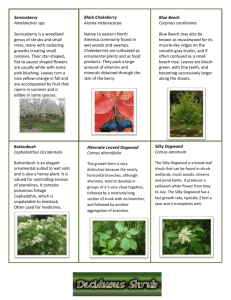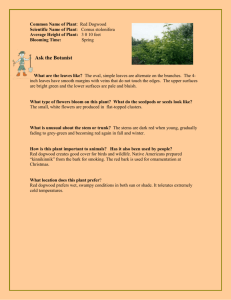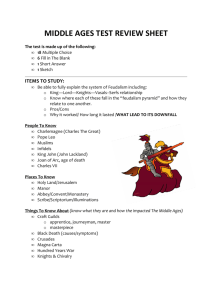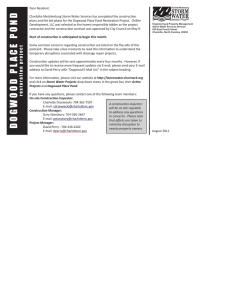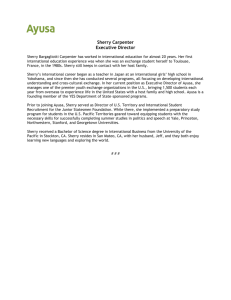Meanings and Theories Geoffrey Nunberg
advertisement
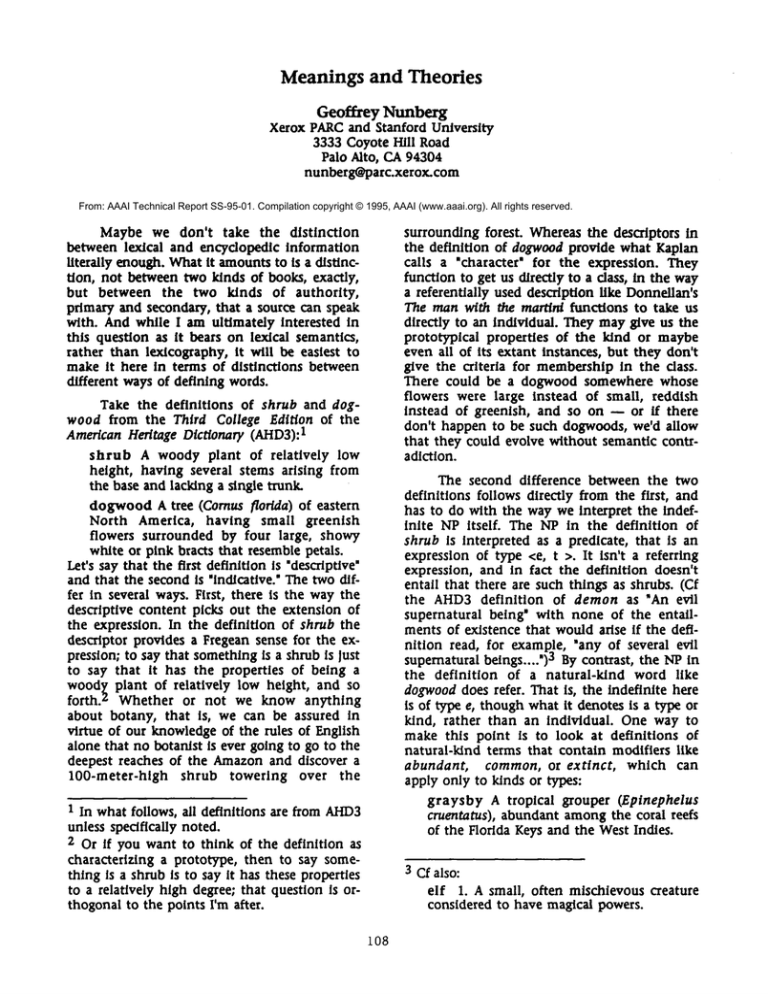
Meanings and Theories Geoffrey Nunberg Xerox PARCand Stanford University 3333 Coyote Hill Road Palo Alto, CA 94304 nunberg@parc.xerox.com From: AAAI Technical Report SS-95-01. Compilation copyright © 1995, AAAI (www.aaai.org). All rights reserved. Maybe we don’t take the distinction between lex/cal and encyclopedic information literally enough. Whatit amounts to Is a dIstlnct/on, not between two kinds of books, exactly, but between the two kinds of authority, primary and secondary, that a source can speak with. And while I am ultimately interested In this question as It bears on lexlcal semantics, rather than lexicography, it will be easiest to make it here in terms of distinctions between different ways of defining words. surrounding forest. Whereas the descriptors In the definition of dogwood provide what Kaplan calls a "character" for the expression. They function to get us directly to a class, In the way a referentially used description like Donnellan’s The man with the martini functions to take us directly to an individual. They may give us the prototyplcal properties of the kind or maybe even all of its extant instances, but they don’t give the criteria for membership in the class. There could be a dogwood somewhere whose flowers were large instead of small, reddish instead of greenish, and so on -- or ff there don’t happen to be such dogwoods, we’d allow that they could evolve without semantic contradiction. Take the definitions of shrub and dogwood from the Third College Edition of the American Heritage Dictionary 1(AHD3): shrub A woody plant of relatively low height, having several stems arising from the base and lacking a single trunk. dogwood A tree (Comus florida) of eastern North America, having small greenish flowers surrounded by four large, showy white or pink bracts that resemble petals. Let’s say that the first definition Is "descriptive" and that the second is ’indicative." The two differ in several ways. First, there is the way the descriptive content picks out the extension of the expression. In the definition of shrub the descriptor provides a Fregean sense for the expression; to say that something Is a shrub Is lust to say that It has the properties of being a wood~ plant of relatively low height, and so forth, z Whether or not we know anything about botany, that is, we can be assured in virtue of our knowledge of the rules of English alone that no botanist Is ever going to go to the deepest reaches of the Amazonand discover a 100-meter-high shrub towering over the 1 In what follows, all definitions are from AHD3 unless specifically noted. 2 Or if you want to think of the definition as characterizing a prototype, then to say something Is a shrub Is to say It has these properties to a relatively high degree;that question ts orthogonal to the points I’m after. 108 The second difference between the two definitions follows directly from the first, and has to do with the way we interpret the IndefInite NP Itself. The NP in the definition of shrub Is Interpreted as a predicate, that is an expression of type <e, t >. It Isn’t a referring expression, and In fact the definition doesn’t entail that there are such things as shrubs. (Cf the AHD3 definition of demon as "An evtl supernatural being’ with none of the entailments of existence that would arise If the definition read, for example, "any of several evil supernatural beings .... ,)3 By contrast, the NP In the definition of a natural-kind word like dogwooddoes refer. That Is, the Indefinite here Is of type e, though what It denotes Is a type or kind, rather than an Individual. One way to make this point Is to look at definitions of natural-kind terms that contain modifiers like abundant, common, or exttnct, which can apply only to kinds or types: graysby A tropical grouper (Eptnephelus cruentatus), abundant amongthe coral reefs of the Florida Keys and the West Indies. 3 Cf also: elf I. A small, often mischievous creature considered to have magicalpowers. that the common dogwood was an instance Comusflorida.). Atlantic croaker A small, silvery food fish (Mtcropogontas undulatus) common In AfianUc waters south of Massachusetts. dodo A large, clumsy, flightiess bird (Raphus cucullatus),formerly of the Island of Mauritius In the Ind/an Ocean, that has 4 beenextinct since the late 17th century. The thirddifference concerns authority. Bothdefinitions speakwithprimaryauthority withregardto the meanings of the expressions thedescriptive content thatconstitutes the senseof shruband the characterof dogwood. (ItIs a matter of linguistic factthatprototyplcal dogwoods havesmallgreenish flowers; it would bea matter of biological factif theyalldid.) But the definition of dogwoodcontains as wellan Independent characterization of the extension of the term,in the form of a taxonomicterm drawnfromthe language of botany. (I say’language,"ratherthana "sublanguage," beacause thesescientific namesdon’treallybelongto English -- foronething, dictionaries don’tfeel themselves obligedto providedefinitions for them, in a rare exception to the principle that the metalanguage of a monollngual dictionary should be contained In the object language.) And as It happens, the definitions of words like these are usually farmed out to scientific specialists, in a very literal application of Putnam’s ’division of linguistic labor.’ With regard to this feature of the definition, at least, the dictionary as such is functioning as a secondary source. (So you can Imagine a lawyer citing the American Heritage Dictionary in support of a legal claim involving the height of shrubs, but not in support of a claim that involved proving 4 We could also make the point by looking at definitions that contain explicit quantification over kinds, a formula that ts often used when the denotation of a natural-kind term contains more than one taxon or scientific class: Jade Either of two distinct minerals, nephrite and Jadeite, that are generally pale green or white .... albatross Any of several large, web-footed birds constituting the family Diomedeldae, chiefly of the oceans of the Southern Hemisphere, and having a hooked beak and long, narrow wings. The definition of lade doesn’t entail that there are only two pieces of Jade in the world, nor does the definition of albatross entail that there are only several such birds. of We have Putnam and the other theorists of direct reference to thank for making us generally aware of these distinctions, but their work has also been responsible for promulgatlng some misconceptions about its nature and extent. The first is that the indicative type of definition is restricted to proper names and natural-kind terms -- that this boils down, in elfect, to a distinction between nominal and metaphysical categories. And Inasmuch as on this view natural kinds are defined by hidden essences that may be inaccessible to current inquiry, people tend to assume that the use of indicative definitions Is inconsistent with specilying the essence of the denotation of the expression. Wecan ask our botanists to provide the technical name of the dogwood, that is, but we can’t expect them to provide the criterial properties for membershipin the class. But in fact there are a lot of words that we define indicatively whose denotations are not natural kinds, at least as the term is ordinarily understood. 5 For example: sherry A fortified Spanish wine ranging from very dry to sweet and from amber to brown. sherry (MW9): A Spanish fortified wine with a distinctly nutty flavor. The definition of sherry is clearly of type e, rather than <e, t >; It refers to a specific type of wine. (The definition admits no other Interpretation, since wine, like liquid but not like beer, can be used as a count noun only when it refers to a type.) And we Interpret the content of the 5 There are also numerous natural-kind words for which the dictionary provides an essentialIst description. For example: base a. Any of a large class of compounds, including the hydroxides and oxides of metals, having a bitter taste, a slippery solution, the ability to turn litmus blue, and the ability to react with acids to formsalts, b. A molecular or Ionic substance capable of combining with a proton to form a new substance, c. A substance that provides a pair of electrons for a covalent bond with an acid. The presence of three senses here is misleading, since all are trying to define the same category, the first in the traditional way, with a pointer, the secondandthird after the fashions of later chemical theories. 109 descrlptlon here merely as Identifying the actual category of sherry, not as providing criteria for membership. There could be n there probably Is ~ an amber-colored or nuttytasting fortified Spanish wine that doesn’t count as sherry; there could be a sherry that is lighter than amber or that doesn’t taste nutty. But at the same time sherry Is not a naturalkind term in the way that alcohol is. We wouldn’t resolve disputes about whether a part/cular sampleof winecountsas sherryby g/ving It to a chemist. But words like these are also different from natural-kind terms, not Just becausethey are name categories that are obviously socially constructed, but becausethe princ/ples of their constitution are more-or-less accessible to us. And dictionaries can and do often prov/de some information about these prlnc/ples. Take the definition of feudalism from Men’/am-Webster’s Ninth Collegiate:.: feudalism (MWg) 1. A political and economic system of Europe from the 9th to about the 15th century, based on the holding of all land In fief or fee and the resultIng relation of lord to vassal and characterized by homage, legal and military service of tenants, and forfeiture. 2. A political, economic, or social order resembling thlsmedievalsystem. The definitionhere containstwo kinds of information. The characterization of feudalism as "a political and economic system of Europe from the 9th to about the 15th century" Is a pointer to the actual category, and in this case ts incorrigible --whatever else feudalism is, it surely reigned in Europe in the late middle ages. Whereas the second part of the definition is essentially a secondary report of a soclo-historlcal theory of feudalism (a rather antiquated one, as It happens), which might be challenged in any of Its particulars with no consequences for the meaning of the word. Someone could argue that there can be feudalism in a money economy, or that there can be feudalism without homage(this last IS effectively what people have said about Russia). Or it could be argued that the social system of medieval Europe was an instance of a universal type, so that it’s wrong to distinguish a separate or extended sense when the word Is applied to Japan. But these aren’t linguistic questions, and It isn’t clear why we should say that these properties constitute a Fregean sense of the word. We could make the same point about any of the following defln/tions, all of which contain heads that are referring expressions: canasta A card game for two to six players, related to rummyand requiring two decks of cards. tartan1 1.a. Any of numerous textile patterns consisting of stripes of varying widths and colors crossed at right angles against a solid background, each forming a distinct/ve design worn by the members of a Scottish clan. tartan2 Nautical. A small, single-masted Mediterranean ship with a large lateen sail. minestrone A thick soup of Italian origin containing assorted vegetables, beans, pasta such as vermicelli or macaroni, and herbs In a meat or vegetable broth. longbow A long, hand-drawn bow, such as that used in medieval England, which sometimes exceeded 6 feet (1.8 meters) length. What these terms have in common with natural-ldnd terms like boxwood is that the categories or kinds they denote are independently constituted, by which I mean that there are some institutions or structures Independent of the language that delimit and define them. In this sense, what counts as canasta or as a tartan (in either sense of the word) Isn’t essentially linguistic question. The chief function of the descriptors In the definitions here is to identify the kind, rather than to give Its essential properties. There are doubtless card games other than canasta which are related to rummy and which require two decks of cards (or If not, we could invent such a game without being obliged to call it canasta). And there could be tartans (the ships) that have never seen the Mediterranean, which Is mentioned here as a pointer to the place where actual tartans are usually found. Hybrid definitions of this type are common enough. For example: impressionism 1. Often Impressionism. A theory or style of painting originating and developed in France during the 1870’s, characterized by concentration on the immediate visual impression produced by a scene and by the use of unmixed primary colors and small strokes to simulate actual reflected light. jazz A style of music, native to America, characterized by a strong but flexible ii0 rhythmic understructure with solo and ensemble improvisations on basic tunes and chord patterns and, more recently, a high/y sopldst/cated harmon/c idiom. The heads of these definitions are clearly referrlng expressions (it helps of course that they contain proper names or descriptions of unique points of or/gln); the material following the "characterized by’ phrase is clearly the summary of a theory of the constitution of the category. But dictionaries are rarely so obliging about distinguishing and labeling the constituents of the/r definitions. In manycases in fact the pointer element is entirely suppressed, so that a theoretical definition is formally indistingishlble from a descriptive definition: fascism A political philosophy, movement, or regime (as that of the Fascist/) that exalts nation and often race above the individual and that stands for a centralized autocratic government headed by a dictatorial leader, severe economic and social regimentation, and forc/ble suppression of opposition. The disjunction of "a polltlcal philosophy, movement, or regime* makes it clear that the definiens here is not a referring expression. At the same t/me we feel confident here that the definition here is not descriptive in quite the same way as the definition of theocracy, say: theocracy 1. A government ruled by or sub}ect to religious authority. For one thing, we could quarrel w/th the definlt/on of fascism without necessarily disputing the meaning of the word. In this sense the definition doesn’t define fascism so much as provide a theory of it, derived from observations of its particular instances (though apart from parenthet/cal "(as that of the Fascist/)’ it makes no mention of how these are to be found. In other cases there maybe no such suggestionat all, and hence It can be hard to tell in the ab. stract whether a definition is giving us a meaning or a theory: gallop 1.a. A natural three-beat gait of a horse, faster than a canter, in which all four feet are off the ground at the same time during each stride. verb (MW9)A word that characteristically the grammatical center of a predicate and expresses an act, occurrence, or mode of being [and] that In various languages Is Inflected for agreement with the subject, for tense, for voice, for mood,or for aspect... Iii epic 1. An extended narrative poem ha elevated or dignified language, celebrating the feats of a legendary or traditional hero. What should we make of the clause In the definition of gallop, "in which all four feet are off the ground at the same time’? Is it a part of the descriptive meaning of the word (that is, is this analytic of gallopIng)? Is It a pointer to the extension of the term? Is it part of an independent theory g and whose? g of the constitution of that extension? Note that the question here isn’t whether the property is essential as opposed to being contingent or stereotypical of galloping, which is the way the distinction between the lerdcal and the encyclopedic is often drawn. What we are asldng, rather, is whether it is the language itself that is imposing this constraint, or whether the language Is simply indexing a constraint that is maintained by some other Institution or structure. However we answer the question, we have to mark the information In an appropriate way in our knowledge representations. The division of linguistic labor is a more complex and pervasive process than we sometimes assume, and affects not lust the margins where ordinary language shades off into technical discourse, but the internal organization of the language. Most of the semantic work that the language does it contracts out, and maybe we should think of it, not as a system, but as an API.

